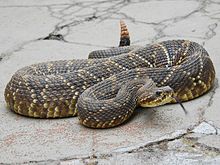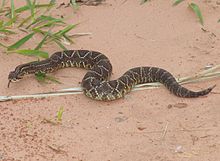| South American rattlesnake | |
|---|---|

| |
| South American rattlesnake (Crotalus durissus terrificus) | |
| Conservation status | |
 Least Concern (IUCN 3.1) | |
| Scientific classification | |
| Domain: | Eukaryota |
| Kingdom: | Animalia |
| Phylum: | Chordata |
| Class: | Reptilia |
| Order: | Squamata |
| Suborder: | Serpentes |
| Family: | Viperidae |
| Genus: | Crotalus |
| Species: | C. durissus |
| Binomial name | |
| Crotalus durissus Linnaeus, 1758 | |

| |
| Synonyms | |
| |
Crotalus durissus, known as the South American rattlesnake, tropical rattlesnake, and by other names, is a highly venomous pit viper species found in South America. It is the most widely distributed member of its genus. Currently, seven subspecies are recognized.
Taxonomy
The Guiana rattlesnake, previously recognized as C. d. dryinus, is now considered a synonym for C. d. durissus. In fact, after the previous nominate subspecies for the C. d. durissus complex became the current nominate for Crotalus simus, which now represents its Mexican and Central American members, C. d. dryinus became the new nominate for the South American rattlesnakes as represented by C. durissus. The subspecies previously known as C. d. collilineatus and C. d. cascavella were moved to the synonymy of C. d. terrificus following the publication of a paper by Wüster et al. in 2005.
Subspecies
| Subspecies | Taxon author | Common name | Geographic range |
|---|---|---|---|
| C. d. cumanensis | Humboldt, 1833 | Venezuelan rattlesnake | Dry lowlands of Venezuela and Colombia |
| C. d. durissus | Linnaeus, 1758 | South American rattlesnake | Coastal savannas of Guyana, French Guiana and Suriname |
| C. d. marajoensis | Hoge, 1966 | Marajon rattlesnake | Known only from Marajo Island, Para State, Brazil |
| C. d. maricelae | García Pérez, 1995 | Bolson arido de Lagunillas, Estado Mérida, Venezuela | |
| C. d. ruruima | Hoge, 1966 | Known from the slopes of Mount Roraima and Mount Cariman-Perú in Venezuela (Bolívar). A few specimens have been recorded in Brazil (Roraima). | |
| C. d. terrificus | (Laurenti, 1768) | Cascavel | Brazil south of the Amazonian forests, extreme southeastern Peru, Bolivia, Paraguay, Uruguay, northern Argentina |
| C. d. trigonicus | Harris & Simmons, 1978 | Inland savannas of Guyana |
- Table notes:
- ^ "Crotalinae". Integrated Taxonomic Information System. Retrieved 26 October 2006.
- ^ Mehrtens JM. 1987. Living Snakes of the World in Color. New York: Sterling Publishers. 480 pp. ISBN 0-8069-6460-X.
- ^ Campbell JA, Lamar WW. 2004. The Venomous Reptiles of the Western Hemisphere. Comstock Publishing Associates, Ithaca and London. 870 pp. 1500 plates. ISBN 0-8014-4141-2.
- Brown JH. 1973. Toxicology and Pharmacology of Venoms from Poisonous Snakes. Springfield, Illinois: Charles C. Thomas. 184 pp. LCCCN 73-229. ISBN 0-398-02808-7.
Description
A large Neotropical rattlesnake, it grows to a length of 1.5 m (4.9 ft), and rarely to a maximum length of 1.9 m (6.2 ft). It has two distinct stripes starting at the base of the head. Within the lines, the color is lighter than the stripes.
The color and pattern of the body are quite variable, most with an 18–32 dorsal with a darker diamond, and rhombic spots, 25–33 (usually 27) rows of dorsal scale in the middle of the body. The head has a dark brown bar at the top, with a dark post-orbital band. The color of the belly varies, it can be white or yellowish, with light gray spots, becoming darker towards the tail. The tail is usually gray, with dark and vague crossed bands.
Behaviour
The species is more active at dusk and in the early hours of the morning; it is highly alert with little warning signs before striking, but like other rattlesnakes they are seldom aggressive towards humans.
Reproduction
The South American rattlesnake has a seasonal reproductive cycle; competition between males (for access to females) begins around the summer's end, with copulation occurring during the fall, and the birth of the young taking place the following spring/summer. Reproduction is ovoviviparous, giving birth to four to eight young. In Roraima, Brazil it has been reported that the gestation lasts for five months, and they are capable of giving birth to up to 14 young.
Diet
The diet consists mainly of rodents, likely due to the great abundance and availability of these animals throughout the year, in most areas where the snakes reside. In some regions, lizards of the Teiidae family are also part of the diet of C. durissus.
Common names
Common names for the species include: South American rattlesnake, tropical rattler, tropical rattlesnake, neotropical rattlesnake, Guiana rattlesnake (previously used for C. d. dryinus). and in Spanish: víbora de cascabel, cascabel, cascabela, and also in Portuguese, cascavel. In Suriname it is known as Sakasneki.
Geographic range
Crotalus durissus is found in South America except the Andes Mountains. However, its range is discontinuous, with many isolated populations in northern South America, including Colombia, Venezuela, Guyana, Suriname, French Guiana and northern Brazil. It occurs in Colombia and eastern Brazil to southeastern Peru, Bolivia, Paraguay, Uruguay, and northern Argentina (Catamarca, Córdoba, Corrientes, Chaco, Entre Rios, Formosa, La Pampa, La Rioja, Mendoza, Misiones, San Juan, San Luis, Santa Fe, Santiago del Estero and Tucumán). It also occurs on some islands in the Caribbean, including Aruba. The type locality given is "America."
Habitat
It prefers savanna and semi-arid zones. It has been reported to occur in littoral xerophilous scrub, psammophilous and halophilous littoral grassland, thorny xerophilous scrub, tropophilous deciduous and semideciduous scrub, as well as tropophilous seasonal semideciduous forest in the northwest of Venezuela. In the Chaco region of Paraguay, it is found in the drier, sandier areas.
Venom

Bite symptoms are very different from those of Nearctic species due to the presence of neurotoxins (crotoxin and crotamine) that cause progressive paralysis. Bites from C. d. terrificus in particular can result in impaired vision or complete blindness, auditory disorders, ptosis, paralysis of the peripheral muscles, especially of the neck, which becomes so limp as to appear broken, and eventually life-threatening respiratory paralysis. The ocular disturbances are sometimes followed by permanent blindness. Phospholipase A2 neurotoxins also cause damage to skeletal muscles and possibly the heart, causing general aches, pain, and tenderness throughout the body. Myoglobin released into the blood results in dark urine. Other serious complications may result from systemic disorders (incoagulable blood and general spontaneous bleeding), hypotension, and shock. Hemorrhagins may be present in the venom, but any corresponding effects are completely overshadowed by the startling and serious neurotoxic symptoms. Acute renal failure is considered as the main cause of death. The mortality rate of cases without specific serum treatment is 72%, and 11% in cases with specific treatment. The LD50 value is 0,047 mg/kg IV, 0,048 mg/kg IP and 1,4 mg/kg IM. The SC median lethal dose varies widely: 0.0478 mg / kg, 0.6 mg / kg, 0.171-0.193 mg / kg, 78 μg / kg and 74 μg / kg. The lethal dose for 60 kg humans is 18 mg, while the venom yield is 100 mg. A study points out that the rattlesnakes in Roraima, Brazil have two types of venom, with different characteristics of individuals of the same species found in other regions, the two types of venom are known as '' yellow venom '' that attacks the nervous system, causing paralysis, and also kidney and respiratory failure, causes muscle pain and makes urine dark, and the "white venom" is hemorrhagic and causes bleeding.
References
- Cacciali, P.; Caicedo, J.R.; Carreira, S.; Fitzgerald, L.; Gutiérrez-Cárdenas, P.; Kacoliris, F.; Montero, R.; Renjifo, J.; Rivas, G.; Rodríguez, J.; Scott, N. (2021). "Crotalus durissus". IUCN Red List of Threatened Species. 2021: e.T178477A44954627. doi:10.2305/IUCN.UK.2021-3.RLTS.T178477A44954627.en. Retrieved 28 August 2024.
- ^ Jonathan A. Campbell; William W. Lamar; Edmund D. Brodie (2004). The venomous reptiles of the Western Hemisphere. Comstock Pub. Associates. p. 1500. ISBN 978-0-8014-4141-7.
- ^ Roy W. MacDiarmid (1999). Snake Species of the World. Herpetologists' League. ISBN 978-1-893777-00-2.
- ^ Mehrtens JM. 1987. Living Snakes of the World in Color. New York: Sterling Publishers. 480 pp. ISBN 0-8069-6460-X
- "Crotalus durissus". Integrated Taxonomic Information System. Retrieved 28 November 2007.
- ^ "Living Hazards Database (LHD) – Search by Scientific Name" (PDF). Acq.osd.mil. Archived from the original (PDF) on 2 July 2017. Retrieved 18 March 2022.
- "Custos reprodutivos em Crotalus durissus (Serpentes, Viperidae) do Estado de São Paulo, Brasil". Bdtd.ibict.br. Archived from the original on 15 March 2022. Retrieved 18 March 2022.
Crotalus durissus possui um ciclo reprodutivo sazonal com cópula ocorrendo no outono e a parturição no final no verão. Os machos competem por fêmeas receptivas.
- ^ "Estudo aponta que em Roraima cascavéis têm hábitos noturnos e dois venenos: 'atributos únicos'". G1 (in Brazilian Portuguese). 3 January 2020. Retrieved 2020-11-01.
- Argaez, Maria Adelaida Hoyos (2012-06-22). A cascavel neotropical Crotalus durissus: uma abordagem morfológica e da historia natural em populações do Brasil (text thesis) (in Brazilian Portuguese). Universidade de São Paulo.
- U.S. Navy. 1991. Poisonous Snakes of the World. US Govt. New York: Dover Publications Inc. 203 pp. ISBN 0-486-26629-X
- Brown JH. 1973. Toxicology and Pharmacology of Venoms from Poisonous Snakes. Springfield, Illinois: Charles C. Thomas. 184 pp. LCCCN 73-229. ISBN 0-398-02808-7
- "Slangen van Suriname - Snakes of South America ( Suriname )". Suriname123.com.
- ^ Laurence Monroe Klauber (1997). Rattlesnakes: Their Habits, Life Histories, and Influence on Mankind (Second ed.). University of California Press. ISBN 978-0-520-21056-1.
- "Archived copy" (PDF). Archived from the original (PDF) on 2020-07-10. Retrieved 2020-09-25.
{{cite web}}: CS1 maint: archived copy as title (link) - Monteiro, H. S. A.; Silva, I. M. S. C. da; Martins, A. M. C.; Fonteles, M. C. (October 2001). "Actions of Crotalus durissus terrificus venom and crotoxin on the isolated rat kidney". Brazilian Journal of Medical and Biological Research. 34 (10): 1347–1352. doi:10.1590/S0100-879X2001001000017. ISSN 0100-879X. PMID 11593312.
- "LD50 and venom yields | snakedatabase.org". snakedatabase.org. Retrieved 2020-03-12.
- D'Império Lima, Maria Regina; Cristina dos Santos, Maria; Tambourgi, Denise Vilarinho; Marques, Thaís; Dias da Silva, Wilmar; Kipnis, Thereza (1991-01-01). "Susceptibility of different strains of mice to South American rattlesnake (Crotalus durissus terrificus) venom: Correlation between lethal effect and creatine kinase release". Toxicon. 29 (6): 783–786. doi:10.1016/0041-0101(91)90070-8. ISSN 0041-0101. PMID 1926179.
- Butantan, Instituto. Coletanea de trabalhos do Instituto Butantan. Instituto Butantan.
Further reading
- Alvaro ME. 1939. Snake Venom in Ophthalmology. Am. Jour. Opth., Vol. 22, No. 10, pp. 1130–1145.
- Wüster W, Ferguson JE, Quijada-Mascareñas JA, Pook CE, Salomão MG, Thorpe RS. 2005. Tracing an invasion: landbridges, refugia and the phylogeography of the Neotropical rattlesnake (Serpentes: Viperidae: Crotalus durissus). Molecular Ecology 14: 1095–1108. PDF at Wolfgang Wüster. Accessed 28 August 2007.
- Wüster W, Ferguson JE, Quijada-Mascareñas JA, Pook CE, Salomão MG, Thorpe RS. 2005. No rattlesnakes in the rainforests: reply to Gosling and Bush. Molecular Ecology, 14: 3619–3621. PDF at Wolfgang Wüster. Accessed 28 August 2007.
- Quijada-Mascareñas A, JE Ferguson, CE Pook, MG Salomão, RS Thorpe, & W Wüster. 2007. Phylogeographic patterns of Trans-Amazonian vicariants and Amazonian biogeography: The Neotropical rattlesnake (Crotalus durissus complex) as an example. Journal of Biogeography 34: 1296–1312. PDF
External links
- [REDACTED] Media related to Crotalus durissus at Wikimedia Commons
- Crotalus durissus at the Reptarium.cz Reptile Database. Accessed 19 August 2007.
| Taxon identifiers | |
|---|---|
| Crotalus durissus | |
- IUCN Red List least concern species
- Crotalus
- Snakes of the Caribbean
- Snakes of Aruba
- Snakes of Brazil
- Reptiles of Bolivia
- Reptiles of Argentina
- Reptiles of Colombia
- Reptiles of French Guiana
- Reptiles of Guyana
- Reptiles of Paraguay
- Reptiles of Peru
- Reptiles of Suriname
- Reptiles of Uruguay
- Reptiles of Venezuela
- Reptiles described in 1758
- Taxa named by Carl Linnaeus